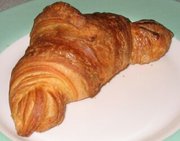Croissant
|
|
A croissant (IPA pronunciation: or ; Template:Audio) is a butter-laden flaky French pastry, named for its distinctive crescent shape. Croissants are made of puff pastry or pâte feuilletée, by layering pastry dough with butter and rolling and folding a few times in succession.
Its versatility, distinctive shape and relative ease of baking have made it the best-known type of French pastry in much of the world. In many parts of the United States, the croissant (introduced at the fast food chains Arby's in the United States and Tim Horton's in Canada in 1983) has come to rival the long-time favorite doughnuts.
Croissant pastry can also be wrapped around almond paste or chocolate before it is baked (in the latter case, it becomes like pain au chocolat, which has a different, non crescent, shape), or sliced to admit sweet or savoury fillings. In France, croissants are generally sold without filling and eaten without added butter; sometimes with almond filling; in the United States, sweet fillings or toppings are common, or warm croissants are filled with ham and cheese or feta cheese and spinach.
Etymology
Fanciful stories of how the pastry was created are modern culinary legends. These include tales that it was invented in Vienna in 1683 to celebrate the defeat of the Turkish siege of the city, as a reference to the crescents on the Turkish flags, when bakers staying up all night heard the tunneling operation and gave the alarm; tales linking croissants with the siege of Budapest in 1686; and those detailing Marie Antoinette's hankering after a Viennese specialty. Alan Davidson, editor of the Oxford Companion to Food states that no printed recipe for the present-day croissant appears in any French recipe book before the early 20th century; the earliest French reference to a croissant he found was among the "fantasy or luxury breads" in Payen's Des substances alimentaires, 1853.
The "Siege of Vienna" story seems to owe its wide diffusion to Alfred Gottschalk, who wrote about the croissant for the first (1938) edition of the Larousse Gastronomique. Gottschalk first cited the legend about the Turkish attack on Budapest in 1686, in the "history of food" section in the same work, he opted for the "siege of Vienna in 1683" version. Compare the Cappuccino legend.
External link
- Food Timeline: (http://www.foodtimeline.org/foodbreads.html#croissants) croissants
- Pastry 101: croissants (http://www.baking911.com/pastry_croissants.htm)de:Croissant

